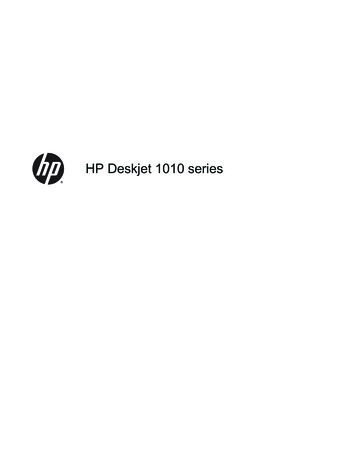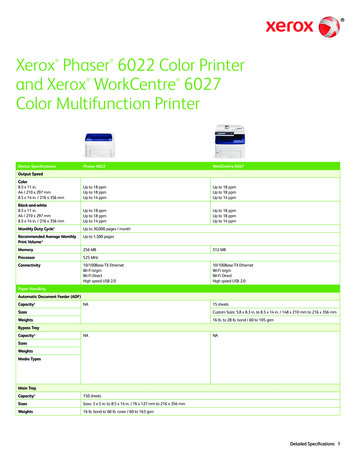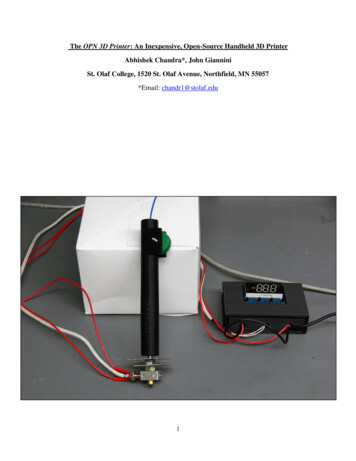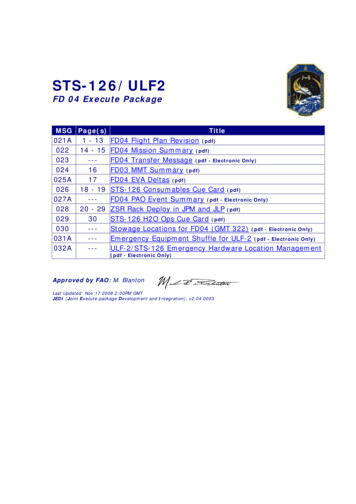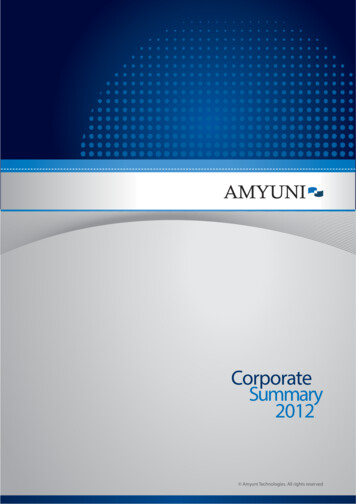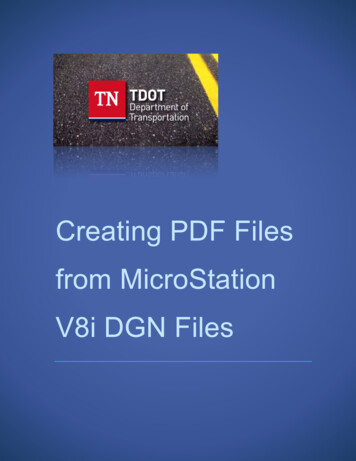
Transcription
Final PDF to printerIntermediate AccountingEIGHTH EDITIONJ. DAVID SPICELANDUniversity of MemphisJAMES F. SEPESanta Clara UniversityMARK W. NELSONCornell UniversityWAYNE B. THOMASUniversity of Oklahomaspi25834 fm i-xxxiii.indd i10/20/14 9:45 PM
Final PDF to printerDedicated to:David’s wife Charlene, daughters Denise and Jessica, and sons Michael David, Michael and DavidJim’s wife Barbara, children Kristina, Matt, and Dave, daughter-in-law Donna, and grandchildren, Kaitlyn,Meghan, and MichaelMark’s wife Cathy, and daughters Liz and ClaraWayne’s wife Julee, daughter Olivia, and three sons Jake, Eli, and LukeINTERMEDIATE ACCOUNTING, EIGHTH EDITIONPublished by McGraw-Hill Education, 2 Penn Plaza, New York, NY 10121. Copyright 2016 by McGraw-Hill Education. All rights reserved. Printedin the United States of America. Previous editions 2013, 2011, 2009, 2007, 2004, 2001, and 1998. No part of this publication may be reproducedor distributed in any form or by any means, or stored in a database or retrieval system, without the prior written consent of McGraw-Hill Education,including, but not limited to, in any network or other electronic storage or transmission, or broadcast for distance learning.Some ancillaries, including electronic and print components, may not be available to customers outside the United States.This book is printed on acid-free paper.1 2 3 4 5 6 7 8 9 0 DOW/DOW 1 0 9 8 7 6 5 4ISBN 978-0-07-8025839MHID 0-07-8025834Senior Vice President, Products & Markets: Kurt L. StrandVice President, General Manager, Products & Markets: Marty LangeVice President, Content Design & Delivery: Kimberly Meriwether DavidManaging Director: Tim VertovecMarketing Director: Brad ParkinsSenior Brand Manager: Natalie KingDirector, Product Development: Rose KoosDirector of Digital Content: Patricia PlumbLead Product Developer: Ann TorbertSenior Product Developer: Rebecca MannSenior Marketing Manager: Kathleen KlehrDigital Product Analyst: Xin LinDirector, Content Design & Delivery: Linda AvenariusProgram Manager: Daryl HorrocksContent Project Managers: Pat Frederickson and Angela NorrisBuyer: Michael R. McCormickDesign: Srdjan SavanovicContent Licensing Specialists: Keri Johnson and Ann Marie JannetteCover Image: Piriya Photography/Getty ImagesCompositor: SPI-GlobalPrinter: R. R. DonnelleyAll credits appearing on page or at the end of the book are considered to be an extension of the copyright page.Library of Congress Cataloging-in-Publication DataSpiceland, J. David, 1949Intermediate accounting / J. David Spiceland, James F. Sepe, Mark W. Nelson, Wayne B. Thomas.—Eighth edition.pages cmISBN 978-0-07-802583-9 (alk. paper)1. Accounting. I. Sepe, James F. II. Nelson, Mark (Mark W.) III. Thomas, Wayne, 1969- IV. Title.HF5636.S773 2015657'.044—dc232014028264The Internet addresses listed in the text were accurate at the time of publication. The inclusion of a website does not indicate an endorsement by theauthors or McGraw-Hill Education, and McGraw-Hill Education does not guarantee the accuracy of the information presented at these sites.www.mhhe.comspi25834 fm i-xxxiii.indd ii10/20/14 9:45 PM
Final PDF to printerAbout the AuthorsDAVID SPICELANDMARK NELSONDavid Spiceland is professor of accounting at the University of Memphis, where he teaches intermediate accounting and other financial accounting courses atthe undergraduate and master’s levels. Hereceived his BS degree in finance fromthe University of Tennessee, his MBAfrom Southern Illinois University, and hisPhD in accounting from the University ofArkansas.Professor Spiceland’s primary researchinterests are in earnings management andeducational research. He has published articles ina variety of journals including The Accounting Review,Accounting and Business Research, Journal of FinancialResearch, and Journal of Accounting Education, and isan author of McGraw-Hill’s Financial Accounting withWayne Thomas and Don Herrmann. David has receiveduniversity and college awards and recognition for histeaching, research, and technological innovations in theclassroom.Mark Nelson is the Eleanora and GeorgeLandew Professor of Accounting atCornell University’s Johnson GraduateSchool of Management, where he teachesintermediate accounting at the MBA level.He received his BBA degree from IowaState University and his MA and PhD degreesfrom Ohio State University. Professor Nelson has woneight teaching awards at Ohio State and Cornell.Professor Nelson’s research is focused on decision making in financial accounting and auditing. His research hasbeen published in The Accounting Review, the Journal ofAccounting Research, Contemporary Accounting Research,Accounting Organizations and Society, and several otherjournals. He has won the American Accounting Association’s Notable Contribution to Accounting Literature Award,and also the AAA’s Wildman Medal for work judged tomake the most significant contribution to the advancementof the public practice of accountancy. He has served threetimes as an editor or associate editor of The AccountingReview, and serves on the editorial boards of several journals. Professor Nelson also served for four years on theFASB’s Financial Accounting Standards Advisory Council.JIM SEPEJim Sepe is an associate professor of accounting atSanta Clara University where he teaches primarily intermediate accounting in both the undergraduate andgraduate programs. He previously taught atCalifornia Poly State University–San LuisObispo and the University of Washingtonand has visited at Stanford University andthe Rome campus of Loyola University ofChicago.Professor Sepe received his BS from SantaClara University, MBA from the University ofCalifornia–Berkeley, and PhD from the University of Washington. His research interests concern financial reporting issues and the use of financial information bycapital markets. He has published articles in The AccountingReview, the Journal of Business Finance and Accounting,Financial Management, the Journal of Forensic Accounting,the Journal of Applied Business Research, and the Journal ofAccounting Education. He is a past recipient of the AmericanAccounting Association’s Competitive Manuscript Awardand has served as a member of the editorial board of TheAccounting Review.Jim has received numerous awards for his teachingexcellence and innovations in the classroom, includingSanta Clara University’s Brutocao Award for Excellence in Curriculum Innovation.WAYNE THOMASWayne Thomas is the John T. Steed Chair and Professor ofAccounting at the University of Oklahoma’s Price Collegeof Business. He received his BS degree from SouthwesternOklahoma State University and his MS and PhD fromOklahoma State University. He has receivedteaching awards at the university, college,and departmental levels, and has receivedthe Outstanding Educator Award from theOklahoma Society of CPAs. He is an authorof McGraw-Hill’s Financial Accountingwith David Spiceland and Don Herrmann.His research focuses on various financialreporting issues and has been published in TheAccounting Review, Journal of Accounting Research, Journal of Accounting and Economics, Contemporary Accounting Research, Review of Accounting Studies, AccountingOrganizations and Society, and others. He has served as aneditor for The Accounting Review and has won the AmericanAccounting Association’s Competitive Manuscript Awardand Outstanding International Accounting Dissertation.Professor Thomas enjoys various activities such astennis, basketball, golf, and crossword puzzles, and mostof all he enjoys spending time with his wife and kids.iiispi25834 fm i-xxxiii.indd iii10/20/14 9:45 PM
Final PDF to printerivPREFACEWhat Stands Out in the Eighth Edition?The FASB and IASB have been working together to issue converged accounting standards that will dramaticallychange key reporting areas, but important differences remain between U.S. GAAP and IFRS. To help instructorsnavigate this challenging environment, the Spiceland team is committed to providing a complete learning system,encompassing the text, key ancillaries, and online content that guide students to a deeper understanding of intermediate accounting topics. All of that content is written by authors Spiceland, Sepe, Nelson, and Thomas.1The Intermediate Accounting learning system is built around three key attributes: current, comprehensive, and clear.“An excellent textbook that covers accounting procedures thoroughly from a real-world perspective. It is very current and is accompanied by a great variety of learning aids to help students succeed.”—Kathy Hsiao Yu Hsu, University of Louisiana-LafayetteCurrent: Few disciplines see the rapid changes that accounting experiences. The Spiceland team is committedto keeping your course up to date. The eighth edition fully integrates the latest FASB and IFRS updates, including: NEW Chapter 5 covering the latest standard on Revenue Recognition (ASU No. 2014-09—Revenue from Contracts with Customers (Topic 606)). Part A introduces the five-step process for recognizing revenue at a point intime, over a period of time, and for contracts with multiple performance obligations. Part B provides comprehensive coverage of specific topics within each of the five steps. Part C applies the five-step process to accounting for long-term contracts, and Part D considers the role of revenue recognition in profitability analysis. ASU No. 2014-08—Presentation of Financial Statements (Topic 205) and Property, Plant, and Equipment (Topic360): Reporting Discontinued Operations and Disclosures of Disposals of Components of an Entity ASU No. 2012-02—Intangibles–Goodwill and Other (Topic 350): Testing Indefinite-Lived Intangible Assets forImpairment Exclusion of extraordinary items and valuation of inventory at the lower of cost and net realizable value Amendments to IFRS No. 9 with respect to classification, measurement and impairment of financial instruments.In addition, current events have focused public attention on the key role of accounting in providing information useful to decision makers. The CPA exam, too, is redirecting its focus to emphasize the professional skills needed tocritically evaluate accounting method alternatives. Intermediate Accounting provides a decision maker’s perspective to emphasize the professional judgment and critical thinking skills required of accountants in today’s businessenvironment.Comprehensive: Authors Spiceland, Sepe, Nelson, and Thomas ensure comprehensive coverage and quality throughout the learning system by writing every major supplement: study guide, instructor’s resource manual,solutions manual, test bank, and website content. All end-of-chapter material, too, is written by the author team andtested in their classrooms before being included in Intermediate Accounting.“This textbook is written in a way that is easy to read, provides clear examples, includes thorough coverage of necessary topics,and provides ample opportunity for practice and mastery of the material through end of chapter problems.”—Terra Brown, University of Texas at Arlington“This is one of the most comprehensive and up-to-date texts for teaching intermediate accounting. It has a good balance of discussion, examples, problem solving and analytical case material, in addition to good integration of IFRS.”— Shailendra Pandit, University of Illinois at Chicagospi25834 fm i-xxxiii.indd iv10/20/14 9:45 PM
Final PDF to printerSPICELAND SEPE NELSON THOMASvCurrent, Comprehensive, ClearComprehensive coverage and quality of Spiceland’s learning system continues in its flexible technology package.As today’s accounting students continue to learn in a digital world, the eighth edition of Spiceland’s learning system features: McGraw-Hill Connect Accounting, SmartBook’s adaptive learning and reading experience, GuidedExamples, and Tegrity Campus. See pages viii–xv for more details!Clear: Reviewers, instructors, and students all have hailed Intermediate Accounting’s ability to explain both simpleand complex topics in language that is clear and approachable. Its highly acclaimed conversational writing style establishes a friendly dialogue between the text and each individual student—creating the impression of speaking withthe student, as opposed to teaching to the student. Intermediate Accounting is written to be the most complete andstudent-friendly book on the market.23New Coauthor Wayne ThomasA new coauthor, Wayne Thomas of the University of Oklahoma, has joined the Spicelandteam for the eighth edition. Wayne is an award-winning professor and a coauthor on thehighly successful Financial Accounting with David Spiceland and Don Herrmann.Added additional algorithmic questions to Connect Accounting—over 2,500 questions available for assignment including more than 1,125 algorithmicquestions.45New to Connect Accounting—CPA and CMA exam multiple choice questions are now available for assignment.These questions are automatically graded and can be assigned to your students along with Kaplan CPA simulations as a way to help your students prep for the CPA exam.PetSmart financial statements for the year ended February 2, 2014, are used throughout eachchapter to illustrate key accounting concepts. PetSmart is a company that will be familiar tomost students and whose operations are easily understood. Its financial statements offer a comprehensive set of material that is presented in a clear manner.“Very well written in a streamlined 21 chapter approach with IFRS incorporated throughout and excellent end of chapter materials.”—Michael Slaubaugh, Indiana University/Purdue UniversitySpiceland’s Financial Accounting SeriesTo allow Intermediate Accounting to be part of a complete learning system, authors DavidSpiceland and Wayne Thomas have teamed up with Don Herrmann to offer FinancialAccounting. Now in its third edition, Financial Accounting uses the same approach thatmakes Intermediate Accounting a success—conversational writing style with a real-worldfocus and author-prepared supplements, combined with McGraw-Hill Connect Accounting.“If you like Spiceland’s intermediate text, you will be thrilled with the financial accounting text. It is written in the sameconversational style, addresses topics directly and clearly, and the illustrations are terrific too.—Nancy Snow, University of Toledo.spi25834 fm i-xxxiii.indd v10/21/14 7:55 PM
Final PDF to printerviPREFACEWhat Keeps SPICELAND Users Coming Back?Where We’re HeadedThese boxes describe the potential financial reporting effects ofmany of the FASB and IASB jointprojects intended to further alignU.S. GAAP and IFRS, as well asother projects the Boards arepursuing separately. Where We’reHeaded boxes allow instructors todeal with ongoing projects to theextent they desire.Financial ReportingCasesWhere We’re HeadedThe FASB is working ona project that could havea dramatic impact onthe format of financialstatements.In 2004, the FASB and IASB began working together on a project, Financial StatementPresentation, to establish a common standard for presenting information in the financialstatements, including classifying and displaying line items and aggregating line items intosubtotals and totals. This project could have a dramatic impact on the format of financialstatements. An important part of the proposal involves the organization of elements ofthe balance sheeteet (statement of financial position), statement of comprehensive income(including the incomencome statement), and statement of cash flows into a common set gress wass slow,“Whereand in 2011both Boardssuspendedactivityallowon the theprojecttoconcentrate on other convergence projects. In 2014, the project was moved back on thetobeupdatedwiththemostcurrentaccountingFASB’s agenda. It is not known if the project will retain its original scope of encompassingall of the financialor ifwithoutit will focusinundatingon one or two statements.At thetime thisial statementschangesthem withneedlessbook was published,shed, no timetable for completion of the project had been announced.technical specifications. A perfect balance!”—Cheryl Bartlett, Indiana University—South BendEach chapter opens with a Financial Reporting Case that placesthe student in the role of the decision maker, engaging the studentspi25834 ch03 112-169.indd 122in an interesting situation relatedFinancial Reporting Case Solutionto the accounting issues to come.1. What purpose do adjusting entries serve? (p. 67) Adjusting entries help ensure thatThen, the cases pose questionsall revenues are recognized in the period goods or services are transferred to customers,regardless of when cash is received. In this instance, for example, 13,000 cash has beenfor the student in the role of decireceived for services that haven’t yet been performed. Also, adjusting entries enable asion maker. Marginal notationscompany to recognize all expenses incurred during a period, regardless of when cashthroughout the chapter point outis paid. Without depreciation, the friends’ cost of using the equipment is not taken intont, the cost of rent is overstated by 3,000 paid inaccount. Conversely, without adjustment,locations where each question isadvance for part of next year’s rent.addressed. The case questionsual incomeWith adjustments, we get an accrualthatprovidesa more com“Thestatementcase atthebeginningof each chapter is veryare answered at the end of theng performance and a better measure for predictplete measure of a company’s operatingarly, thebalance sheet providesmore thecompleteing future operating cash flows. Similarly,captivating.After I areadcase, I wanted to getchapter.ources of futureure cash receipts and disbursements.assessment of assets and liabilities as sourcespaper and pencil and answer the questions.”Decision Makers’Perspective8/1/14 2:59 PM—Carol Shaver, Louisiana Tech Universityspi25834 ch02 050-111.indd 857/25/14These sections appear throughoutthe text to illustrate how accounting information is put to work inDecision Makers’ Perspectivetoday’s firms. With the CPA examplacing greater focus on applicaCash often is referred to as a nonearning asset because it earns no interest. For this reason,tion of skills in realistic work setmanagers invest idle cash in either cash equivalents or short-term investments, both of whichprovide a return. Management’s goal is to hold the minimum amount of cash necessary totings, these discussions help yourconduct normal business operations, meet its obligations, and take advantage of opportunistudents gain an edge that willties. Too much cash reduces profits through lost returns, while too little cash increases risk.remain with them as they enterThis trade-off between risk and return is an ongoing choice made by management (internaldecision makers). Whether the choice made is appropriate is an ongoing assessment madethe workplace.sion makers).by investors and creditors (external decision“This is an excellent feature of the book. It isA company must have cash available for the compensating balances we discussed in the Companies hold cashso importantknowoperating,why andhow toinformationpay for planned andprevious section as well as for planned disbursementsrelated totonormalinvesttransactionsing, and financing cash flows. However,, becausecash inflowsand justoutflowscan vary fromtheunplannedis usedand notmemorizing“right”andto satisfyplanned amounts, a company needs an additional cash cushion as a precaution against sur- compensating balanceabilit too convert cash equivalentsequiprises. The size of the cushion depends onn the answers.”company’s abilityrequirements.9:41 AMcklkl along with its short term borrowing capacityand short term investments into cash quickly—Jeff Mankin, Lipscomb Universityspi25834 fm i-xxxiii.indd vi10/20/14 9:45 PM
Final PDF to printerSPICELAND SEPE NELSON THOMASviiIn talking with so many intermediate accounting faculty, we heard more than how to improve the book—there was much, much more that both users and nonusers insisted we not change. Here are some of the features that have made Spiceland such a phenomenal success in its previous editions.Additional ConsiderationDiscounts in Contracts with Multiple Performance Obligations. Note that Illustration 5–7shows that Tri-Box systems are sold at a discount—TrueTech sells the system for atransaction price ( 250) that’s less than the 300 sum of the stand-alone selling pricesof the Tri-Box module ( 240) and the subscription to Tri-Net ( 60). Because there isno evidence that the discount relates to only one of the performance obligations, it isspread between them in the allocation process. If TrueTech had clear evidence from salesof those goods and services that the discount related to only one of them, the entirediscount would be allocated to that good or service.“This is a good technique that I actually use in myclass and it’s good to see it in a book!”—Ramesh Narasimhan, Montclair State UniversityAdditionalConsideration BoxesThese are “on the spot” considerations of important, butincidental or infrequent aspectsof the primary topics to whichthey relate. Their parentheticalnature, highlighted by enclosure in Additional Consideration boxes, helps maintain anappropriate level of rigor oftopic coverage without sacrificing clarity of explanation.Ethical DilemmasEthical DilemmaYou recently have been employed by a large retail chain that sells sporting goods. Oneof your tasks is to help prepare periodic financial statements for external distribution. Thechain’s largest creditor, National Savings & Loan, requires quarterly financial statements,and you are currently working on the statements for the three-month period endingJune 30, 2016.During the months of May annd June, the company spent 1,200,000 on a hefty radioand TV advertising campaign. TheT 1,200,000the costs ofboxesproducingthe“Having includedethical dilemmain everychaptercommercials as well as the radioo and TV time purchased to air the commercials. All of theismuchmoresignificantthanhavingaseparatecosts were charged to advertising expense. The company’s chief financial officer (CFO)has asked you to prepare a June 30 chapteradjusting entryto removethe costsfrom advertisingdevotedto ethics.Studentscan relate toexpense and to set up an asset called prepaid advertising that will be expensed in July.theimportanceofbeingethicalineveryaspect ofThe CFO explained that “This advertisingacampaign has led to significant sales in Maydealings.”and June and I think it will contiinue businessto bring in customersthrough the month of July.By recording the ad costs as an asset, we can match the cost of the advertising with theadditional July sales. Besides, iff we expensetheWorthy,advertisingin May and June,we will show—GloriaSouthwestTennesseeCommunity CollegeBroaden Your PerspectiveApply your critical-thinking ability to the knowledge you’ve gained. These cases will provide you an opportunity todevelop your research, analysis, judgment, and communication skills. You also will work with other students, integrate what you’ve learned, apply it in real-world situations, and consider its global and ethical ramifications. Thispractice will broaden your knowledge and further develop your decision-making abilities.JudgmentCase 4–1Earnings qualityThe financial community in the United States has become increasingly concerned with the quality of reportedcompany earnings. LO4–2, LO4–3Required:Because ethical ramificationsof business decisions impact somany individuals as well as thecore of our economy, EthicalDilemmas are incorporatedwithin the context of accounting issues as they are discussed.These features lend themselvesvery well to impromptu classdiscussions and debates.Broaden YourPerspective CasesFinish each chapter with thesepowerful and effective cases,a great way to reinforce andexpand concepts learned in thechapter. Star ProblemsIn each chapter, particularlychallenging problems, designated by a , require studentsto combine multiple conceptsor require significant use ofjudgment.1. Define the termm earningsquality. students would benefit tremendously from“I think2. Explain the distinction between permanent and transitory earnings as it relates to the concept of earningsthe cases.”—Joyce Njoroge, Drake Universityspi25834 fm i-xxxiii.indd vii10/20/14 9:45 PM
Final PDF to printerviiiPREFACEEasy to Use. Proven Effective.McGraw-Hill CONNECT ACCOUNTINGMcGraw-Hill Connect Accounting is a digital teaching and learning environment that gives students the means to betterconnect with their coursework, with their instructors, and with the important concepts that they will need to know for success now and in the future. With Connect Accounting, instructors can deliver assignments, quizzes and tests easily online.Students can review course material and practice important skills.Connect Accounting provides all the following features: SmartBook and LearnSmart Auto-graded online homework Powerful learning resources including guided examples to pinpoint and connect key concepts for review.In short, Connect Accounting offers students powerful tools and features that optimize their time and energy, enablingthem to focus on learning.SMARTBOOK, POWERED BY LEARNSMARTLearnSmart is the market-leading adaptive study resource that is proven to strengthen memory recall, increase class retention, and boost grades. LearnSmart allows students to study more efficiently because they aremade aware of what they know and don’t know.SmartBook, which is powered by LearnSmart, is thefirst and only adaptive reading experience designed tochange the way students read and learn. It creates a personalized reading experience by highlighting the most impactful concepts a student needs to learn at that moment in time.As a student engages with SmartBook, the reading experience continuously adapts by highlighting content based on whatthe student knows and doesn’t know. This ensures that the focus is on the content he or she needs to learn, while simultaneously promoting long-term retention of material. Use SmartBook’s real-time reports to quickly identify the conceptsthat require more attention from individual students—or the entire class. The end result? Students are more engaged withcourse content, can better prioritize their time, and come to class ready to participate.“Using Connect Accounting and LearnSmart is great in any class, but really enhances online and hybrid sections. Weare having better success with our online and hybrid classes as a result of having these tools available to us.”—Patti Lopez, Valencia Collegespi25834 fm i-xxxiii.indd viii10/20/14 9:45 PM
Final PDF to printerSPICELAND SEPE NELSON THOMASixTailored to You.ONLINE ASSIGNMENTSConnect Accounting helps students learn more efficientlyby providing feedback and practice material when theyneed it, where they need it. Connect grades homeworkautomatically and gives immediate feedback on any questions students may have missed. Our assignable, gradableend-of-chapter content includes a general journal application that looks and feels more like what you would find ina general ledger software package. Also, select questionshave been redesigned to test students’ knowledge morefully. They now include tables for students to work throughrather than requiring that all calculations be done offline.GUIDED EXAMPLESThe guided examples in Connect Accounting provide anarrated, animated, step-by-step walk-through of selectexercises in Intermediate Accounting similar to those assigned. These short presentations can be turned on or offby instructors and provide reinforcement when studentsneed it most.“Great for an online class [and] for students that need the extra help in learning a process.”—Terry Elliott, Morehead State Universityspi25834 fm i-xxxiii.indd ix10/20/14 9:46 PM
Final PDF to printerxPREFACECPA SimulationsKaplan CPA Exam Simulations allow students to practice intermediate accounting concepts in aweb-based environment similar to that used in the actual CPA exam. There will be no hesitation orconfusion when your students sit for the real exam: they’ll know exactly what they need to do.CPA and CMA Review Questions—Now Available in Connect Accounting!A CPA and CMA Review Questions section includes multiple-choice questions adapted from a variety of sources including questions developed by the AICPA Board of Examiners and those usedin the Kaplan CPA Review Course to prepare for the CPA examination and focus on the key topicswithin each chapter, permitting quick and efficient reinforcement of those topics as well as conveying a sense of the way the topics are covered in the CPA exam. Also, a special section of multiplechoice questions illustrates coverage of IFRS. The CMA questions are adapted from questions thatpreviously appeared on Certified Management Accountant (CMA) exams.CPA and CMA Review QuestionsCPA ExamQuestionsThe following questions are adapted from a variety of sources includinguding questions developed by the AICPA BoardAccountingis precurrent,of Examiners and those used in the Kaplan CPA Review Course to study“Intermediateaccounting for incometaxes whileparing for the CPA examination. Determine the response that best completesthe statementsor questions.complete,well written,and highly de-tailed. It belongs in the library of anyone LO16–1nues in its 2016 financial statements, of which1. Scott Corp. received cash of 20,000 that was included in revenueswhopreparingthe CPA 12,000 will not be taxable until 2017. Scott’s enacted tax rate is 30%for is2016,and 25% forfor 2017.Whatexam.”amount should Scott report in its 2016 balance sheet for deferreded income tax liability?—Barbara K. Parks, Americana. 2,000Intercontinental University—Onlineb 2 400STUDENT RESOURCE LIBRARYThe Connect Accounting Student Resources give students access to additional resources such as recorded lectures, onlinepractice materials, quizzes, Excel templates, alternative exercises and problems, an e
Intermediate Accounting is written to be the most complete and student-friendly book on the market. New Coauthor Wayne Thomas A new coauthor, Wayne Thomas of the University of Oklahoma, has joined the Spiceland team for the eighth edition. Wayne is an award-winning professor and a coauthor on the highly su




